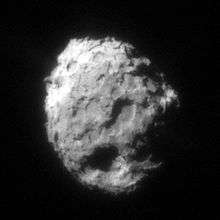60P/Tsuchinshan
| Discovery | |
|---|---|
| Discovered by | Tsuchinshan (Observatory) |
| Discovery date | January 11, 1965 |
| Alternative designations |
1965 II; 1971 X; 1978 XVI; 1985 X; 1992 XII |
| Orbital characteristics A | |
| Epoch |
2011-Nov-15 (JD 2455880.5) |
| Aphelion | 5.398 AU |
| Perihelion | 1.618 AU |
| Semi-major axis | 3.508 AU |
| Eccentricity | 0.5387 |
| Orbital period | 6.785 a |
| Inclination | 3.609° |
| Last perihelion |
May 13, 2012[1][2] December 24, 2005[1] |
| Next perihelion | December 11, 2018[1] |
60P/Tsuchinshan, also known as Tsuchinshan 2, is a periodic comet in the solar system with an orbital period of 6.79 years.[3] Tsuchinshan is the Wade-Giles transliteration corresponding to the pinyin Zĭjīn Shān, which is Mandarin Chinese for "Purple Mountain".
It was discovered at the Purple Mountain Observatory, Nanking, China on 11 January 1965 with a magnitude estimated as a very faint 15. The elliptical orbit was computed to give a perihelion date of 9 February 1965 with an orbital period of 6.69 years. Revised calculations predicted the next perihelion would be on 28 November 1971 and Elizabeth Roemer of the University of Arizona successfully relocated the comet with the 154-cm reflector at Catalina. It was also observed in 1978, 1985, 1991-1992, and 1998-1999.
The comet peaked at about apparent magnitude 16.3 in 2012.[4] On 29 December 2077 the comet will pass 0.068 AU (10,200,000 km; 6,300,000 mi) from Mars.[5]
See also
References
- 1 2 3 Seiichi Yoshida (2011-11-08). "60P/Tsuchinshan 2". Seiichi Yoshida's Comet Catalog. Retrieved 2012-02-18.
- ↑ Syuichi Nakano (2009-04-22). "60P/Tsuchinshan 2 (NK 1766)". OAA Computing and Minor Planet Sections. Retrieved 2012-02-20.
- ↑ "60P/Tsuchinshan 2". Retrieved 22 February 2015.
- ↑ Seiichi Yoshida (2011-12-07). "60P/Tsuchinshan 2 (2012)". Seiichi Yoshida's Comet Catalog. Retrieved 2010-03-01.
- ↑ "JPL Close-Approach Data: 60P/Tsuchinshan 2" (2011-11-14 last obs). Retrieved 2012-02-20.
External links
- Orbital simulation from JPL (Java) / Horizons Ephemeris
- 60P/Tsuchinshan 2 – Seiichi Yoshida @ aerith.net
- Elements and Ephemeris for 60P/Tsuchinshan – Minor Planet Center
- 60P at Kronk's Cometography
| Numbered comets | ||
|---|---|---|
| Previous 59P/Kearns–Kwee |
60P/Tsuchinshan | Next 61P/Shajn–Schaldach |

